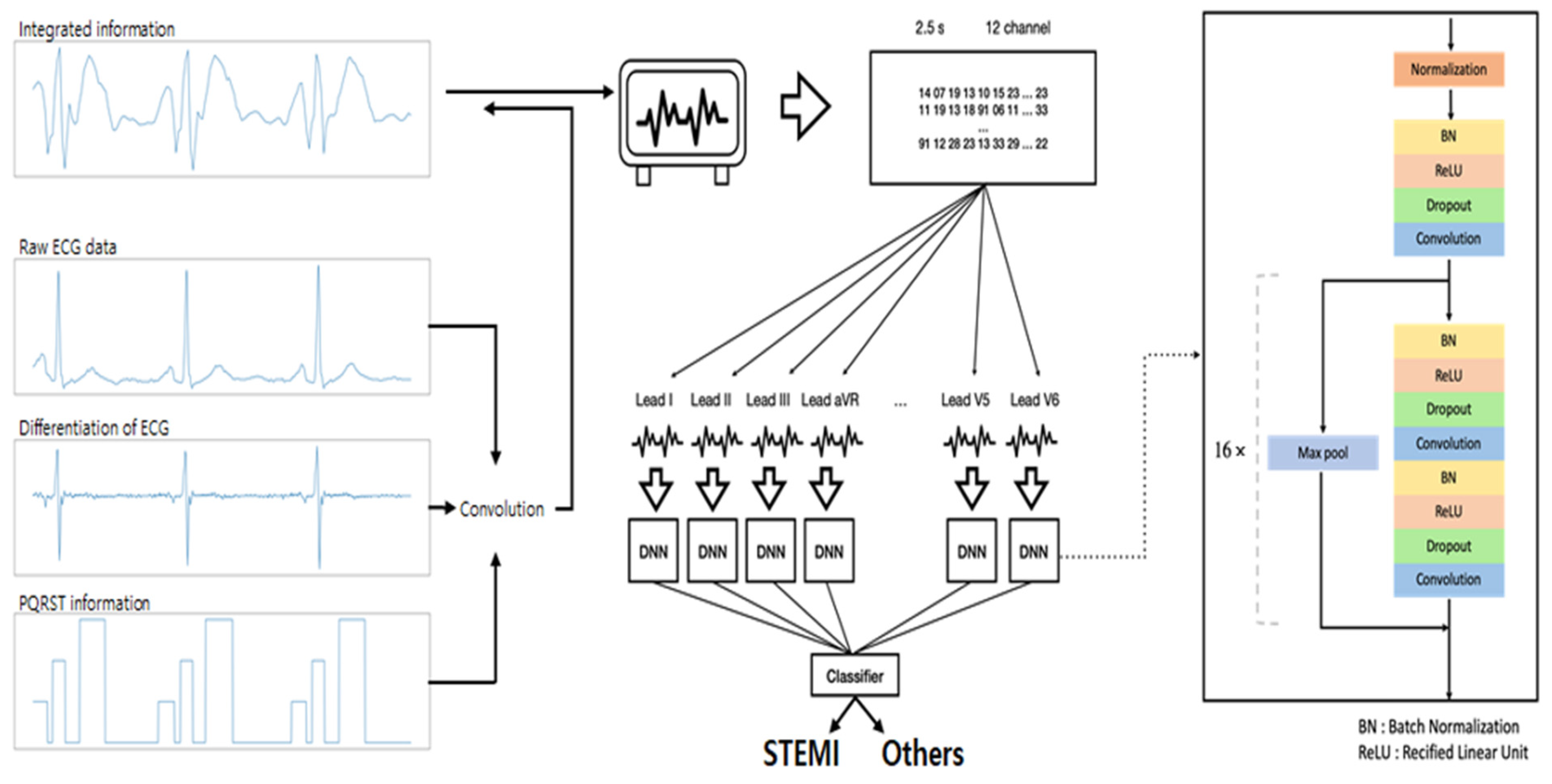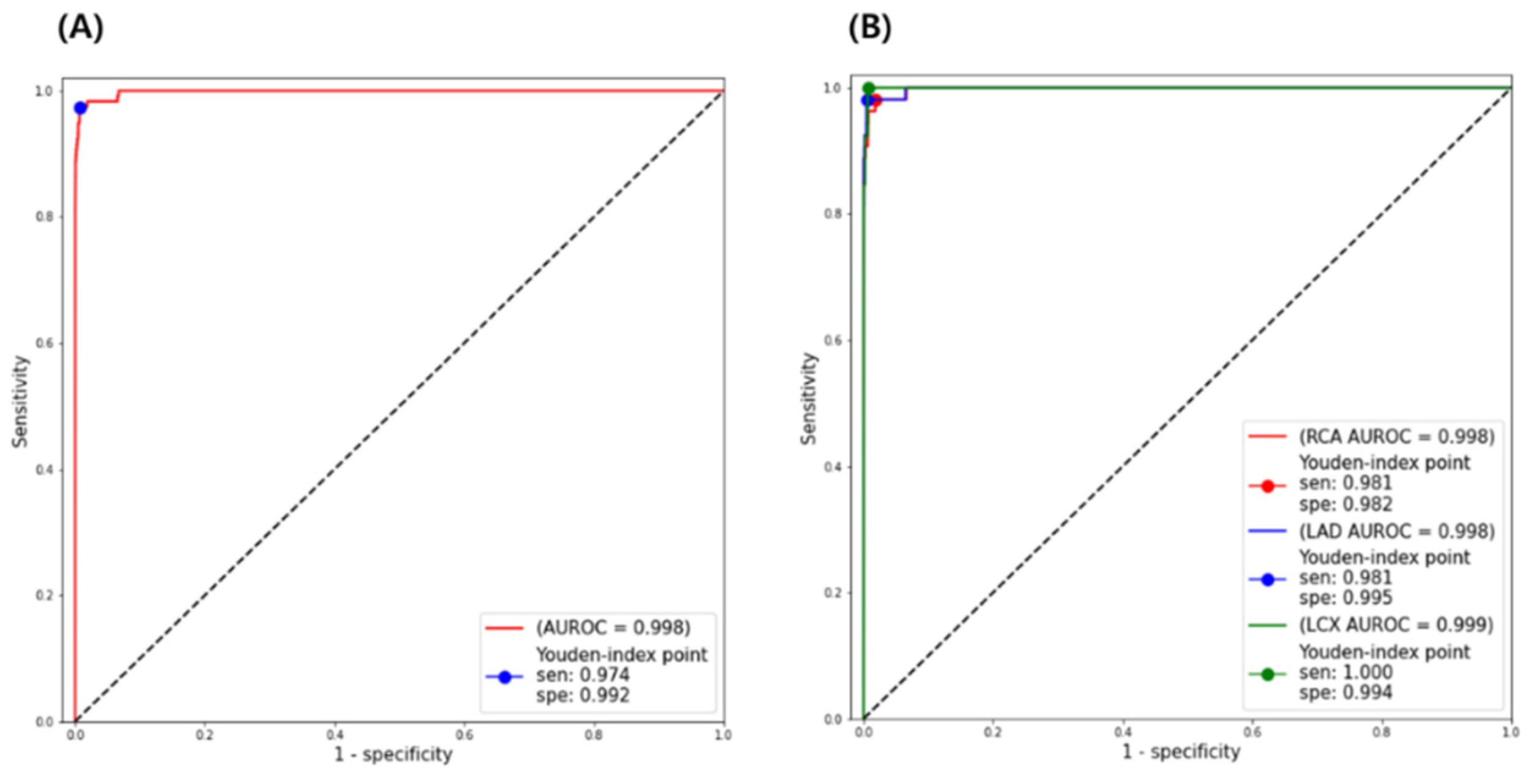Diagnostic Accuracy of the Deep Learning Model for the Detection of ST Elevation Myocardial Infarction on Electrocardiogram
Abstract
:1. Introduction
2. Materials and Methods
2.1. Study Design
2.2. Outcomes
2.3. Application of Deep Learning Model
2.4. Statistical Analysis
3. Results
3.1. Diagnostic Accuracy of DLM between STEMI-ECGs versus NSR-ECGs
3.2. Analysis for False Positive and False Negative Results
4. Discussion
5. Conclusions
Supplementary Materials
Author Contributions
Funding
Institutional Review Board Statement
Informed Consent Statement
Data Availability Statement
Conflicts of Interest
References
- Xue, Y.; Shen, J.; Hong, W.; Zhou, W.; Xiang, Z.; Zhu, Y.; Huang, C.; Luo, S. Risk stratification of ST-segment elevation myocardial infarction (STEMI) patients using machine learning based on lipid profiles. Lipids Health Dis. 2021, 20, 48. [Google Scholar] [CrossRef] [PubMed]
- Debrabant, B.; Halekoh, U.; Soerensen, M.; Møller, J.E.; Hassager, C.; Frydland, M.; Palstrøm, N.; Hjelmborg, J.; Beck, H.C.; Rasmussen, L.M. STEMI, Cardiogenic Shock, and Mortality in Patients Admitted for Acute Angiography: Associations and Predictions from Plasma Proteome Data. Shock 2021, 55, 41–47. [Google Scholar] [CrossRef] [PubMed]
- Rodríguez-Padial, L.; Fernández-Pérez, C.; Bernal, J.L.; Anguita, M.; Sambola, A.; Fernández-Ortiz, A.; Elola, F.J. Differences in in-hospital mortality after STEMI versus NSTEMI by sex. Eleven-year trend in the Spanish National Health Service. Rev. Española Cardiol. 2020, 74, 510–517. [Google Scholar] [CrossRef]
- Meyers, H.P.; Bracey, A.; Lee, D.; Lichtenheld, A.; Li, W.J.; Singer, D.D.; Kane, J.A.; Dodd, K.W.; Meyers, K.E.; Thode, H.C.; et al. Comparison of the ST-Elevation Myocardial Infarction (STEMI) vs. NSTEMI and Occlusion MI (OMI) vs. NOMI Paradigms of Acute MI. J. Emerg. Med. 2021, 60, 273–284. [Google Scholar] [CrossRef] [PubMed]
- Hollander, J.E.; Than, M.; Mueller, C. State-of-the-Art Evaluation of Emergency Department Patients Presenting With Potential Acute Coronary Syndromes. Circulation 2016, 134, 547–564. [Google Scholar] [CrossRef] [PubMed] [Green Version]
- Clark, E.N.; Sejersten, M.; Clemmensen, P.; Macfarlane, P.W. Automated Electrocardiogram Interpretation Programs Versus Cardiologists’ Triage Decision Making Based on Teletransmitted Data in Patients With Suspected Acute Coronary Syndrome. Am. J. Cardiol. 2010, 106, 1696–1702. [Google Scholar] [CrossRef] [PubMed]
- Bond, R.R.; Novotny, T.; Andrsova, I.; Koc, L.; Sisakova, M.; Finlay, D.; Guldenring, D.; McLaughlin, J.; Peace, A.; McGilligan, V.; et al. Automation bias in medicine: The influence of automated diagnoses on interpreter accuracy and uncertainty when reading electrocardiograms. J. Electrocardiol. 2018, 51, S6–S11. [Google Scholar] [CrossRef] [PubMed]
- Novotny, T.; Bond, R.R.; Andrsova, I.; Koc, L.; Sisakova, M.; Finlay, D.D.; Guldenring, D.; Spinar, J.; Malik, M. Data analysis of diagnostic accuracies in 12-lead electrocardiogram interpretation by junior medical fellows. J. Electrocardiol. 2015, 48, 988–994. [Google Scholar] [CrossRef] [PubMed]
- Gregg, R.E.; DeLuca, D.C.; Chien, C.-H.S.; Helfenbein, E.D.; Ariet, M. Automated serial ECG comparison improves computerized interpretation of 12-lead ECG. J. Electrocardiol. 2012, 45, 561–565. [Google Scholar] [CrossRef]
- Xiong, P.; Xue, Y.; Liu, M.; Du, H.; Wang, H.; Liu, X. Detection of inferior myocardial infarction based on densely connected convolutional neural network. J. Biomed. Eng. 2020, 37, 142–149. [Google Scholar] [CrossRef]
- Wang, H.; Zhao, W.; Jia, D.; Hu, J.; Li, Z.; Yan, C.; You, T. Myocardial Infarction Detection Based on Multi-lead Ensemble Neural Network. In Proceedings of the 2019 41st Annual International Conference of the IEEE Engineering in Medicine and Biology Society (EMBC) International Conference of the IEEE Engineering in Medicine and Biology Society, Berlin, Germany, 23–27 July 2019; Institute of Electrical and Electronics Engineers (IEEE): Piscataway, NJ, USA, 2019; Volume 2019, pp. 2614–2617. [Google Scholar]
- Liu, W.-C.; Lin, C.-S.; Tsai, C.-S.; Tsao, T.-P.; Cheng, C.-C.; Liou, J.-T.; Lin, W.-S.; Cheng, S.-M.; Lou, Y.-S.; Lee, C.-C. A deep learning algorithm for detecting acute myocardial infarction. EuroIntervention 2021, 17, 765–773. [Google Scholar] [CrossRef] [PubMed]
- Couture, E.L.; Bérubé, S.; Dalery, K.; Gervais, A.; Harvey, R.; Nguyen, M.; Parenteau, É.; Daneault, B. Culprit Vessel Revascularization Prior to Diagnostic Angiography as a Strategy to Reduce Delays in Primary Percutaneous Coronary Intervention. Circ. Cardiovasc. Interv. 2016, 9, e003510. [Google Scholar] [CrossRef] [PubMed]
- Thygesen, K.; Alpert, J.S.; Jaffe, A.S.; Chaitman, B.R.; Bax, J.J.; Morrow, D.A.; White, H.D. Fourth Universal Definition of Myocardial Infarction (2018). J. Am. Coll. Cardiol. 2018, 72, 2231–2264. [Google Scholar] [CrossRef]
- He, K.; Zhang, X.; Ren, S.; Sun, J. Deep residual learning for image recognition. In Proceedings of the 2016 IEEE Conference on Computer Vision and Pattern Recognition (CVPR), Las Vegas, NV, USA, 27–30 June 2016. [Google Scholar]
- Acharya, U.R.; Fujita, H.; Oh, S.L.; Hagiwara, Y.; Tan, J.H.; Adam, M. Application of deep convolutional neural network for automated detection of myocardial infarction using ECG signals. Inf. Sci. 2017, 415–416, 190–198. [Google Scholar] [CrossRef]
- Baloglu, U.B.; Talo, M.; Yildirim, O.; Tan, R.S.; Acharya, U.R. Classification of myocardial infarction with multi-lead ECG signals and deep CNN. Pattern Recognit. Lett. 2019, 122, 23–30. [Google Scholar] [CrossRef]
- Hannun, A.Y.; Rajpurkar, P.; Haghpanahi, M.; Tison, G.H.; Bourn, C.; Turakhia, M.P.; Ng, A.Y. Cardiologist-level arrhythmia detection and classification in ambulatory electrocardiograms using a deep neural network. Nat. Med. 2019, 25, 65–69. [Google Scholar] [CrossRef] [PubMed]
- Schläpfer, J.; Wellens, H.J. Computer-Interpreted Electrocardiograms. J. Am. Coll. Cardiol. 2017, 70, 1183–1192. [Google Scholar] [CrossRef] [PubMed]
- Rokos, I.C. Artificial intelligence for STEMI detection: The “Shanghai Algorithm” provides a step forward. Int. J. Cardiol. 2020, 317, 231–232. [Google Scholar] [CrossRef] [PubMed]
- Aminorroaya, A.; Tajdini, M.; Masoudkabir, F. Time for clinicians to revisit their perspectives on C-statistic. Eur. Heart J. 2020, 42, 132–133. [Google Scholar] [CrossRef] [PubMed]



| Experimental Group Diagnosed with STEMI (n = 117) STEMI Detection by the Automated ECG Interpretation | |||
|---|---|---|---|
| Factors | Failure (n = 31) | Success (n = 86) | p-value * |
| Sex, male | 24 (77.4%) | 70 (81.4%) | 0.63 |
| Age, years | 61.3 ± 10.5 | 58.2 ± 11.8 | 0.41 |
| Underlying diseases | |||
| DM | 6 (19.4%) | 15 (17.4%) | 0.81 |
| HTN | 16 (51.6%) | 37 (43%) | 0.41 |
| Angina | 0 (0%) | 1 (1.2%) | 1.0 |
| CHF | 0 (0%) | 0 (0%) | NA |
| CKD | 1 (3.2%) | 3 (3.5%) | 1.0 |
| Past history | |||
| Smoking, pack year | 20.3 ± 18.1 | 19.5 ± 17.6 | 0.92 |
| Previous PCI | 0 (0%) | 1 (1.2%) | 1.0 |
| PO medication | |||
| Aspirin | 1 (3.2%) | 4 (4.7%) | 1.0 |
| Antiplatelet | 0 (0%) | 2 (2.3%) | 1.0 |
| ACE inhibitor | 0 (0%) | 0 (0%) | NA |
| Statin | 0 (0%) | 1 (1.2%) | 1.0 |
| Laboratory findings | |||
| Troponin I, pg/mL | 21.6 (0.2–102.6) | 3.2 (0–128.5) | 0.29 |
| CK-MB, ng/mL | 3.4 (1.7–9.9) | 2.7 (1.3–7.2) | 0.34 |
| BNP, pg/mL | 41 (10.3–167.2) | 25.9 (10.3–65.5) | 0.31 |
| Cr, mg/dL | 0.9 (0.7–1) | 0.9 (0.7–1) | 0.93 |
| Vital signs | |||
| HR, bpm | 73.7 ± 17.5 | 77.3 ± 19.6 | 0.29 |
| SBP, mmHg | 132.1 ± 25.8 | 133.7 ± 28.3 | 0.57 |
| DBP, mmHg | 84 ± 18.5 | 83.6 ± 17.7 | 0.50 |
| Patient outcomes | |||
| Arrest | 1 (3.2%) | 9 (10.5%) | 0.28 |
| ECMO | 1 (3.2%) | 5 (5.8%) | 1.0 |
| TTM | 0 (0%) | 0 (0%) | NA |
| Pacemaker | 1 (3.2%) | 3 (3.5%) | 1.0 |
| MV | 2 (6.5%) | 9 (10.5%) | 0.72 |
| Hospital admission, day | 5.4 ± 3.9 | 5.9 ± 4.2 | 0.42 |
| ICU stay, day | 4.3 ± 4.4 | 3.8 ± 2.5 | 0.44 |
| Survival | 30 (96.8%) | 82 (95.3%) | 1.0 |
| Culprit artery | 0.132 | ||
| LAD | 14 (45.2%) | 27 (31.4%) | |
| LCX | 0 (0%) | 7 (8.1%) | |
| RCA | 13 (41.9%) | 25 (29.1%) | |
| LAD-LCX | 2 (6.5%) | 4 (4.7%) | |
| LAD-RCA | 1 (3.2%) | 12 (14%) | |
| LCX-RCA | 0 (0%) | 6 (7%) | |
| LAD-LCX-RCA | 1 (3.2%) | 5 (5.8%) | |
| Coronary Culprit Artery | AUROC (95% CI) | Sensitivity (%) (95% CI) | Specificity (%) (95% CI) | Positive Predictive Value % (95% CI) | Negative Predictive Value % (95% CI) |
|---|---|---|---|---|---|
| Overall STEMI (n = 117) | 0.998 (0.996–0.999) | 97.4 (95.7–100) | 99.2 (98.1–99.4) | 20.2 (9.2–21.9) | 99.9 (99.9–100.0) |
| RCA-STEMI (n = 63; 38 RCA, 13 LAD-RCA, 6 LCX-RCA, 6 LAD-LCX-RCA) | 0.998 (0.995–0.999) | 98.1 (95.8–100) | 98.2 (93.5–99.4) | 4.6 (1.3–11.7) | 99.9 (99.9–100.0) |
| LAD-STEMI (n = 66; 41 LAD, 6 LAD-LCX, 13 LAD-RCA, 6 LAD-LCX-RCA) | 0.998 (0.996–0.999) | 98.1 (95.4–100) | 99.5 (99.4–99.8) | 15.7 (15.7–35.2) | 99.9 (99.9–100.0) |
| LCX-STEMI (n = 25; 7 LCX, 6 LAD-LCX, 6 LCX-RCA, 6 LAD-LCX-RCA) | 0.999 (0.998–1.000) | 100 (100–100) | 99.4 (99.3–99.9) | 3.2 (3.2–66.6) | 100.0 (99.9–100.0) |
| Control Group (n = 412) | Baseline Wander (−) (n = 67) | Baseline Wander (+) (n = 345) | p-Value * |
|---|---|---|---|
| Real STEMI † | 3 (4.5%) | 7 (2%) | 0.49 |
| Not STEMI | 64 (95.5%) | 338 (98%) | |
| STE ‡ | 15 (22.4%) | 29 (8.4%) | 0.001 |
| No STE | 52 (77.6%) | 316 (91.6%) |
Publisher’s Note: MDPI stays neutral with regard to jurisdictional claims in published maps and institutional affiliations. |
© 2022 by the authors. Licensee MDPI, Basel, Switzerland. This article is an open access article distributed under the terms and conditions of the Creative Commons Attribution (CC BY) license (https://creativecommons.org/licenses/by/4.0/).
Share and Cite
Choi, H.Y.; Kim, W.; Kang, G.H.; Jang, Y.S.; Lee, Y.; Kim, J.G.; Lee, N.; Shin, D.G.; Bae, W.; Song, Y. Diagnostic Accuracy of the Deep Learning Model for the Detection of ST Elevation Myocardial Infarction on Electrocardiogram. J. Pers. Med. 2022, 12, 336. https://doi.org/10.3390/jpm12030336
Choi HY, Kim W, Kang GH, Jang YS, Lee Y, Kim JG, Lee N, Shin DG, Bae W, Song Y. Diagnostic Accuracy of the Deep Learning Model for the Detection of ST Elevation Myocardial Infarction on Electrocardiogram. Journal of Personalized Medicine. 2022; 12(3):336. https://doi.org/10.3390/jpm12030336
Chicago/Turabian StyleChoi, Hyun Young, Wonhee Kim, Gu Hyun Kang, Yong Soo Jang, Yoonje Lee, Jae Guk Kim, Namho Lee, Dong Geum Shin, Woong Bae, and Youngjae Song. 2022. "Diagnostic Accuracy of the Deep Learning Model for the Detection of ST Elevation Myocardial Infarction on Electrocardiogram" Journal of Personalized Medicine 12, no. 3: 336. https://doi.org/10.3390/jpm12030336
APA StyleChoi, H. Y., Kim, W., Kang, G. H., Jang, Y. S., Lee, Y., Kim, J. G., Lee, N., Shin, D. G., Bae, W., & Song, Y. (2022). Diagnostic Accuracy of the Deep Learning Model for the Detection of ST Elevation Myocardial Infarction on Electrocardiogram. Journal of Personalized Medicine, 12(3), 336. https://doi.org/10.3390/jpm12030336






